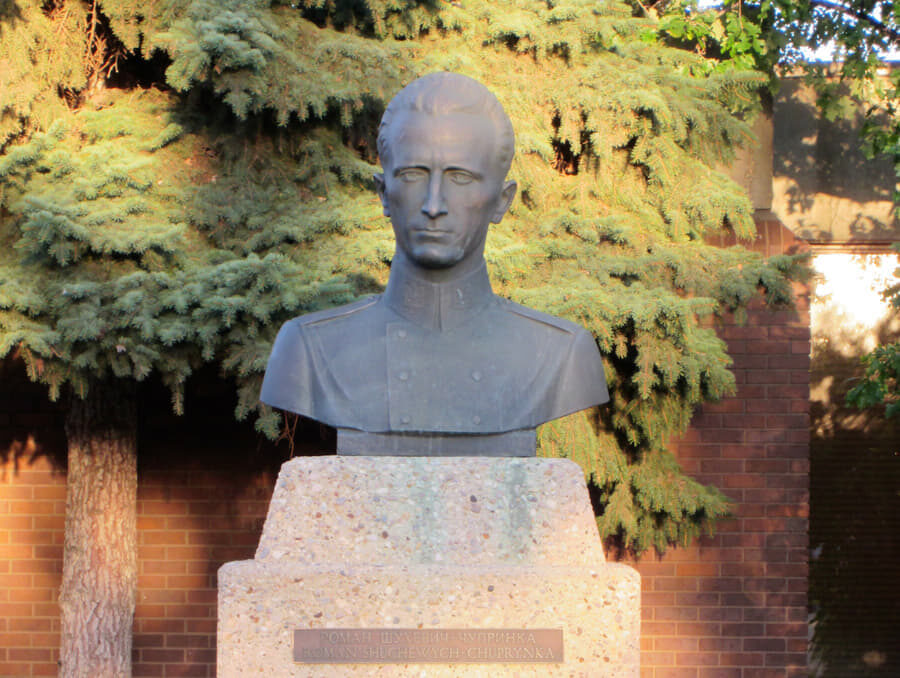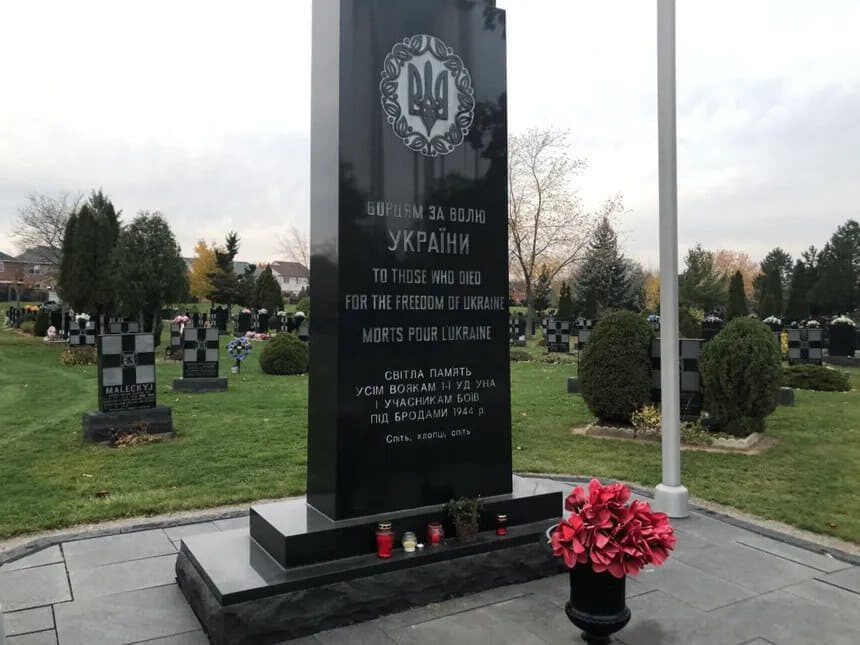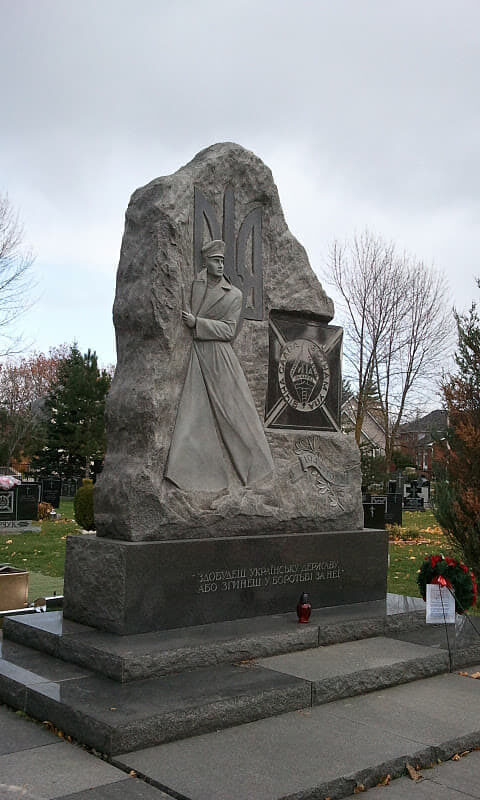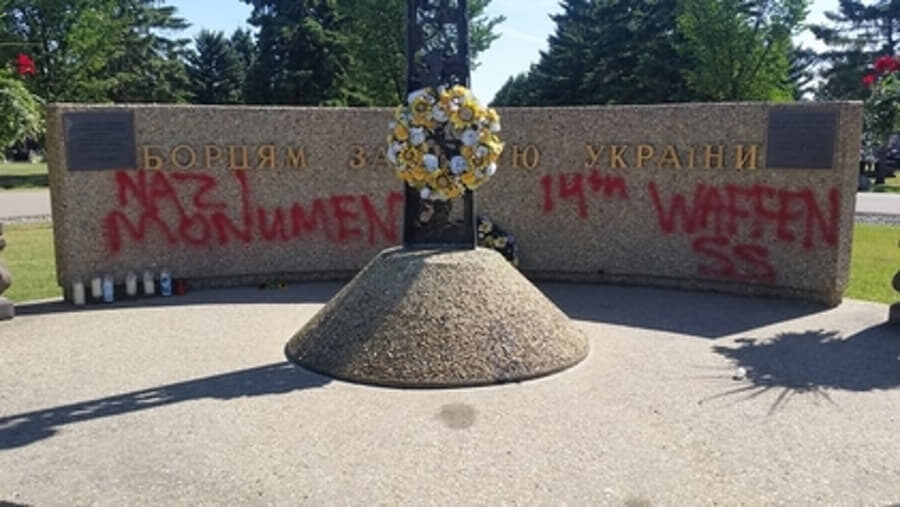Given the fact that Ukraine and Nazis are again
making news, it is important to point out that there are indeed commemorative
monuments to Ukrainian Nazis in Canada, located where the Ukrainian populations are the greatest. The reasons for such monuments are known to the Ukrainian community alone, but so it is essential to make a record of them here, along with a hint at what those being commemorated did back in the days of World War Two.
Roman Shukhevych

© The Postil MagazineOutside of the Ukrainian Youth Unity Complex, north Edmonton, Alberta. Source "Ukrainian partisans and their allies burned homes, shot or forced back inside those who tried to flee, and used sickles and pitchforks to kill those they captured outside. Churches full of worshipers were burned to the ground. Partisans displayed beheaded, crucified, dismembered, or disemboweled bodies, to encourage remaining Poles to flee... It was this maimed OUN-Bandera, led by Mykola Lebed' and then Roman Shukhevych, that cleansed the Polish population from Volhynia in 1943" (
The Reconstruction of Nations).
1st Galician, 14th Waffen Grenadier Division of the SS

© Sam Fleming/RSJMonument to 1st Galician, 14th Waffen Grenadier Division of the SS (St. Volodymyr Ukrainian Cemetery, Oakville, Ontario. Source "The 14th Division of the Ukrainian SS surrounded the village Huta Pieniacka from three sides... The people were gathered in the church or shot in the houses. Those gathered in the church — men, women and children — were taken outside in groups, children killed in front of their parents. Some men and women were shot in the cemetery, others were gathered in barns where they were shot" (
British archives).
Monument to the Glory of the UPA

© The Postil MagazineMonument to the Glory of the UPA
(St. Volodymyr Cemetery, Oakville, Ontario).
"One of their major tasks as UPA partisans was the cleansing of the Polish presence from Volhynia. Poles tend to credit the UPA's success in this operation to natural Ukrainian brutality; it was rather a result of recent experience. People learn to do what they are trained to do, and are good at doing what they have done many times. Ukrainian partisans who mass-murdered Poles in 1943 followed the tactics they learned as collaborators in the Holocaust in 1942: detailed advance planning and site selection; persuasive assurances to local populations prior to actions; sudden encirclements of settlements; and then physical elimination of human beings.
Ukrainians learned the techniques of mass murder from Germans. This is why UPA ethnic cleansing was striking in its efficiency, and why Volhynian Poles in 1943 were nearly as helpless as Volhynian Jews in 1942. It is one reason why the campaign against Poles began in Volhynia rather than Galicia, since in Volhynia the Ukrainian police played a greater role in the Final Solution" (
The Reconstruction of Nations).
Monument to the 14th Waffen SS Grenadier Division
© The Psotil Magazine14th Waffen SS Grenadier Division (St. Michael’s Cemetery, Edmonton, Alberta).
"On that day, early in the morning, soldiers of this division, dressed in white, masking outfits, surrounded the village. The village was cross-fired by artillery. SS-men of the 14th Division of the SS 'Galizien' entered the village, shooting the civilians rounded up at a church. The civilians, mostly women and children, were divided and locked in barns that were set on fire. Those who tried to run away were killed. Witnesses interrogated by the prosecutors of the Head Commission described the morbid details of the act. The crime was committed against women, children, and newborn babies" (
The Institute of National Remembrance. Commission for the Prosecution of Crimes against the Polish Nation).
Related Articles:
- Justin Trudeau and the Banderites
- Is Canada now a Nazi State?
- Ukrainian Nationalism: Russian Special Operation — Denazification of Ukraine
- O Canada!
- After The Anti-Racist Struggle At Trinity College - The Wokeness Crown
- Universities As Political Actors: The Case Of UBC







Reader Comments